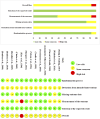Optimization of high-intensity resistance exercise protocols for improving bone mineral density in the elderly without chronic diseases: a systematic review and network meta-analysis
- PMID: 40556957
- PMCID: PMC12185277
- DOI: 10.3389/fphys.2025.1589200
Optimization of high-intensity resistance exercise protocols for improving bone mineral density in the elderly without chronic diseases: a systematic review and network meta-analysis
Abstract
Objective: This study aims to explore the effects of high-intensity resistance exercise (HIRE) protocols on improving bone mineral density (BMD) in the elderly without chronic diseases by using a forest plot and network meta-analysis.
Methods: A systematic search was performed across seven databases including PubMed, Web of Science, Embase, Cochrane Library, China National Knowledge Infrastructure, Wan Fang and VIP, to investigate the effects of HIRE on BMD in the elderly by December 9, 2024. The search strategy incorporated Boolean operators (AND, OR, NOT) to refine the selection of relevant studies. The methodological quality was assessed by using Risk of Bias tool 2 and Tool for the Assessment of Study Quality and Reporting in Exercise, and data analysis was performed using Stata 17.
Results: A total of 13 RCTs involving 616 participants were included. Among the various HIRE protocols, two demonstrated positive effects on lumbar spine and whole-body BMD, while four were positive in improving femoral neck BMD compared to the control group. The network meta-analysis revealed that 3M(9-10) was more effective than 2M(6-8), 3M(6-8) and 1M(6-8) in enhancing lumbar spine BMD. However, no significant differences were observed among the HIRE protocols for femoral neck and whole body BMD. According to the SUCRA rankings, 3M(9-10) was the most effective protocol for improving lumbar spine (94.7%) and femoral neck BMD (82.3%), while 2M(9-10) ranked highest for whole body BMD improvement (61.6%).
Conclusion: HIRE protocol is critical to ensure BMD improvement for elderly without chronic diseases, and not all HIRE protocols yield positive effects on BMD. Compared to other sites, lumbar spine BMD appears to be more responsive to HIRE. A 2-3 times, multiple-set regimen may be more beneficial for improving lumbar spine, whole-body, and femoral neck BMD in the elderly, and performing 9-10 repetitions per set is particularly important for improving BMD in older adults.
Systematic review registration number: https://www.crd.york.ac.uk/PROSPERO/, identifier registration number. CRD42024543517.
Keywords: bone mineral density; elderly; meta-analysis; network; osteopenia; resistance exercise; resistance training; strength.
Copyright © 2025 Cheng, Yi, Bo, Mao and Ma.
Conflict of interest statement
The authors declare that the research was conducted in the absence of any commercial or financial relationships that could be construed as a potential conflict of interest.
Figures







Similar articles
-
Progressive high-intensity resistance training and bone mineral density changes among premenopausal women: evidence of discordant site-specific skeletal effects.Sports Med. 2006;36(8):683-704. doi: 10.2165/00007256-200636080-00005. Sports Med. 2006. PMID: 16869710
-
Effectiveness and safety of vitamin D in relation to bone health.Evid Rep Technol Assess (Full Rep). 2007 Aug;(158):1-235. Evid Rep Technol Assess (Full Rep). 2007. PMID: 18088161 Free PMC article.
-
Systemic pharmacological treatments for chronic plaque psoriasis: a network meta-analysis.Cochrane Database Syst Rev. 2021 Apr 19;4(4):CD011535. doi: 10.1002/14651858.CD011535.pub4. Cochrane Database Syst Rev. 2021. Update in: Cochrane Database Syst Rev. 2022 May 23;5:CD011535. doi: 10.1002/14651858.CD011535.pub5. PMID: 33871055 Free PMC article. Updated.
-
Systemic pharmacological treatments for chronic plaque psoriasis: a network meta-analysis.Cochrane Database Syst Rev. 2017 Dec 22;12(12):CD011535. doi: 10.1002/14651858.CD011535.pub2. Cochrane Database Syst Rev. 2017. Update in: Cochrane Database Syst Rev. 2020 Jan 9;1:CD011535. doi: 10.1002/14651858.CD011535.pub3. PMID: 29271481 Free PMC article. Updated.
-
Interventions for promoting habitual exercise in people living with and beyond cancer.Cochrane Database Syst Rev. 2018 Sep 19;9(9):CD010192. doi: 10.1002/14651858.CD010192.pub3. Cochrane Database Syst Rev. 2018. PMID: 30229557 Free PMC article.
References
-
- Armamento-Villareal R., Aguirre L., Waters D. L., Napoli N., Qualls C., Villareal D. T. (2020). Effect of aerobic or resistance exercise, or both, on bone mineral density and bone metabolism in obese older adults while dieting: a randomized controlled trial. J. Bone Mineral Res. 35 (3), 430–439. 10.1002/jbmr.3905 - DOI - PMC - PubMed
-
- Ataeinosrat A., Saeidi A., Abednatanzi H., Rahmani H., Daloii A. A., Pashaei Z., et al. (2022). Intensity dependent effects of interval resistance training on myokines and cardiovascular risk factors in males with obesity. Front. Endocrinol. (Lausanne) 13, 895512. 10.3389/fendo.2022.895512 - DOI - PMC - PubMed
Publication types
LinkOut - more resources
Full Text Sources

